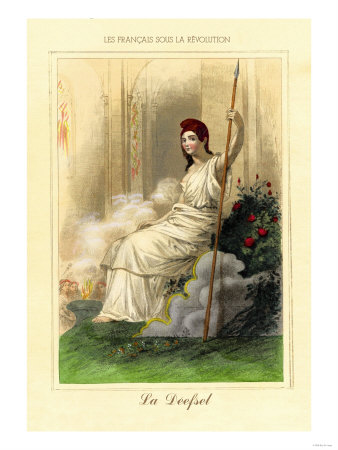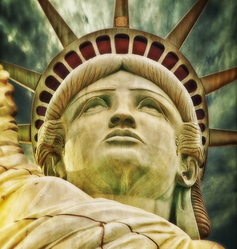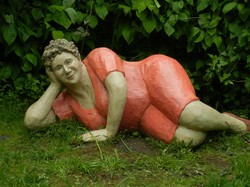By now, Napoleon's administration had gone in the carnage of the Franco-Prussian War and in its place was the Third Republic, which was much more open to the idea of Libertas statues. They went for it, and the Americans couldn't exactly turn it down, when it was a gift.
They wanted to. Deputations of vicars and priests besieged House representatives about the undesirability of a Pagan Goddess on US soil. J.P. Morgan led a consortium of wealthy and corporate classes, lobbying with the message that the Statue of Liberty would inspire unrest amongst American lower classes.
Questions were asked in Congress, but the conclusion was soon reached that turning Liberty down would be political poison. It would severely harm diplomatic relations with France. The US Ambassador to France Levi Parsons Morton was directed to formally accept the present of one colossal Statue of Liberty, which he did so on July 4th, 1884.
Phase two of the American resistance would delay progress on the statue immensely. Morgan et al hoped indefinitely.
While the Statue of Liberty itself was being paid for via public subscription from the people of France, the USA would have to fund its pedestal. Bartholdi wanted one, as Liberty's aspect on Bedloe Island (now renamed Liberty Island) would allow for a better view of Her from the harbor, if only She was further elevated.
It was widely anticipated that the upper echelons of US society would stump up the cash. But J.P. Morgan and chums had already stated their position on the subject. No, no, and again no. The 1% weren't interested in Libertas nor anything She stood for.
That other great source of fund-raising in America - collections amongst church congregations - was also out. Their clerics were adamant in their outrage against Pagan Goddesses. Liberty was preached against as if She was Satan Himself.
Faced with potential diplomatic embarrassment - the US having to tell France that they were too strapped for money to accept their gift - a governmental committee was set up to find ways to elicit donations towards the pedestal.
It found an ally in Joseph Pulitzer, the American journalist whose name would later be immortalized in the Pulitzer Prize for outstanding journalism. He wrote dozens of widely read editorials, which helped turn enough public sentiment towards the construction that the pedestal could be built.
Ordinary Americans (the 99% if you like) were responsible for funding Liberty, as was right and proper given her allegorical history.
Meanwhile, the French public were watching the Statue of Liberty being built in Paris. With the vision in front of them, funded from their own collective pockets, there was a surge of enthusiasm for the project. The authorities were suddenly swamped with requests to keep Libertas's statue in France.
But the Third Republic government couldn't do that. It had already been offered to the USA. Withdrawing it would cause diplomatic offense.
In short, both US and French governments would have secretly breathed a huge sigh of relief, if the Statue of Liberty could stay in Paris. But neither could mention it to the other for fear of harming international relations!
































 St Tydecho's Churches in West Waleson 09/03/2014
St Tydecho's Churches in West Waleson 09/03/2014
 Goodies for an Outlander Premiere Partyon 03/06/2015
Goodies for an Outlander Premiere Partyon 03/06/2015
 Holocaust Memorial Day Interview with Rainer Höss, Grandson of Rudolf Architect of Auschwitzon 01/24/2015
Holocaust Memorial Day Interview with Rainer Höss, Grandson of Rudolf Architect of Auschwitzon 01/24/2015
 Romantic Valentine Gifts for an Outlander Fanon 01/16/2015
Romantic Valentine Gifts for an Outlander Fanon 01/16/2015



Comments
Awww! Thank you so much! <3
I've got plans for these articles. I'm just trying to figure out the best way to showcase them.
Like I always say: "If you can't create your own original good stuff to share, go flaunt and brag about somebody else stuff." You can quote me on that. :)
I'm glad that you enjoyed the articles on Liberty. :)
Now Lady Justice is a fascinating figure. There's at least four different goddess merged together to complete Her modern aspect, and that's with stripping away each of those Ladies' subsequent manifestations. Let it settle in my head a bit, then you never know. It might turn into an article.
Ms Hilvers is a credit to your country, and floating around here somewhere too.
I don't know this Ms. Hilvers, but if she's one of your favorite ladies she must be OK. You picked my favorite lady to write about and I'm glad you spread it out over a 3-part article. Do you plan to do a series about Lady Justice? She's another one of my favorite ladies. I'll bet if you did Wizzles about her, you would do her justice. :)
Unless you're a contender to be ruler of a nation, the worst Sovereignty can really do is leave. Though that's bad enough, if the leaving means that you're about to be invaded. Or the crops will fail etc. As long as you get on well with the conquerors and be prepared to give up your entire culture, things should work out nice.
LOL I wouldn't call them insights persay, so much as a change from hearing the word sovereignty and thinking of it as in the definition of the word to the idea of what it means in a Pagan (or Celtic?) sense. I guess I think of scary but not really (>.>as my dream the other night might prove >.>) Goddesses. You honestly don't want to know what I actually think. :| I'll try to figure out how to explain it. In the simplest sense, you don't want to be on her bad side. I'm going to leave it at: it's kind of complicated.
Ah! Yes, I remember that conversation too. I'll add Argante to the list of subjects for articles.
What insights have you gained regarding Sovereignty? It's always interesting to hear different people's takes on such things.
And yes! The OWS really could have run with this. I thought about that as I was writing this, but it didn't occur to me at the time it was all happening in Liberty Plaza. Then again, the name says it all. So perhaps they did pick up on it, but kept it subtle.
Haha, when you first said something, I was thinking it was going to be a piece on the Lady of the Lake. I am definitely not disappointed though! And I definitely do remember asking about this (I was kind of like 'OOOH! This story!' when I saw it :D) and I remember your response at the time, as well. But from that shorter telling I hadn't picked up on the people's reaction toward the statue, so much as just what she represented, which I do find interesting. And, anyways, now I have a lot more context for the idea of a Sovereignty Goddess than when I was first asking. Changes my understanding in that sense, too.
Actually, I kind of love that governments/leading bodies of sorts were terrified that she represented an inspiration to people rebelling. I wish the OWS movement had picked up on that one, (unless they did and I just totally missed it which is plausible), I love how fitting it is, considering. :D
When you Tweeted to me this afternoon that you knew what was coming and were looking forward to it, I looked at my nearly completed trilogy and bit my lip somewhat. You were clearly expecting something and you didn't know I was doing this. I worried you'd be disappointed! :)
I'm glad that the first part, at least, has captured your attention.
I was doing this on Saturday. Yesterday, I disappeared into Zazzle. Not quite so exciting. LOL
Also! I must say, whenever you randomly disappear for a few days but aren't on some sort of break, I usually take it to mean something has captured your interest and you're all wrapped up in it, and that the end result will eventually be an article, which I think tend to be some of your best! XD.
So I was waiting for that when you told me about this article this morning, and that was an exciting surprise! :D